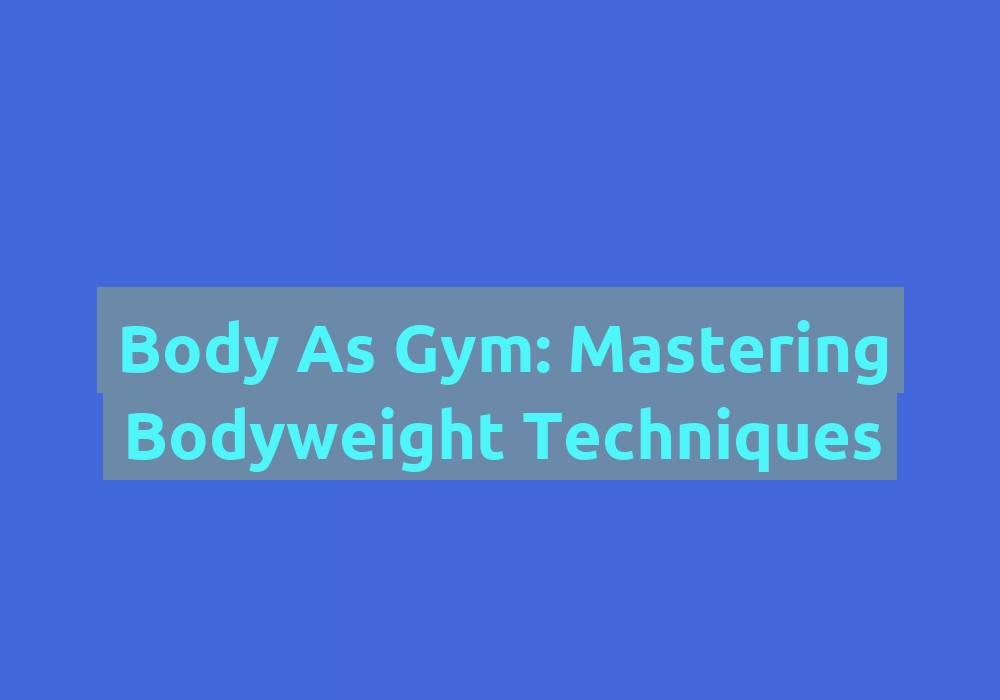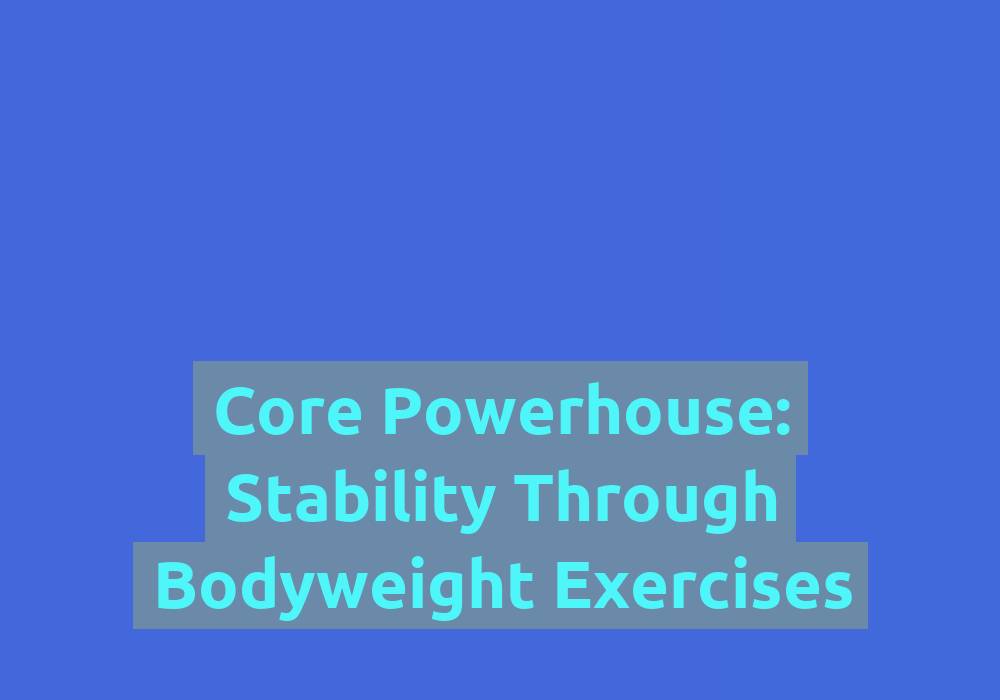Body as Gym: Mastering Bodyweight Techniques

In recent years, the fitness industry has witnessed a surge in popularity when it comes to bodyweight training. With the rise of social media influencers showcasing their impressive bodyweight feats, more and more individuals are turning to this accessible and effective form of exercise. Bodyweight training involves utilizing your own body as resistance to build strength, improve flexibility, and enhance overall fitness. In this article, we will delve into the numerous benefits of bodyweight training and provide you with an in-depth guide on mastering various bodyweight techniques.
The Benefits of Bodyweight Training
-
Convenience: One of the greatest advantages of bodyweight training is its convenience. Unlike traditional gym workouts, bodyweight exercises can be performed anywhere, anytime, without the need for expensive equipment. Whether you are in the comfort of your own home, traveling, or enjoying the great outdoors, your body becomes the gym. This flexibility allows you to maintain your fitness routine even when you are on the go or unable to access a gym.
-
Cost-effectiveness: Another compelling reason to embrace bodyweight training is its cost-effectiveness. Gym memberships and equipment can be expensive, but with bodyweight exercises, all you need is your own body. This makes it an ideal option for those on a tight budget or individuals who prefer to save money. You can achieve a challenging and effective workout without the need for any additional purchases.
-
Versatility: Bodyweight exercises offer endless possibilities for training. From push-ups and squats to planks and burpees, there is a wide range of movements that target various muscle groups. This versatility allows you to tailor your workouts to your specific goals, whether it’s building strength, improving endurance, or increasing flexibility. Additionally, bodyweight exercises can be modified and progressed to suit your fitness level, ensuring that you continue to challenge your body as you progress.
-
Functional Strength: Bodyweight training focuses on functional movements that mimic real-life activities, making it highly practical. By mastering bodyweight techniques, you not only increase your overall strength but also improve your ability to perform everyday tasks with ease. Whether it’s lifting heavy objects, carrying groceries, or playing sports, the functional strength gained through bodyweight training translates into improved performance in various activities.
-
Progressive Overload: One common misconception about bodyweight training is that it is limited in terms of progression. However, this couldn’t be further from the truth. With bodyweight exercises, you can gradually increase the difficulty by adjusting the leverage, range of motion, or adding variations. For example, you can elevate your feet during push-ups to increase the intensity or perform one-legged squats to challenge your balance and strength. This concept of progressive overload ensures continued growth and challenges your muscles to adapt and become stronger.
Mastering Bodyweight Techniques
1. Push-ups
Push-ups are considered one of the most effective bodyweight exercises that engage multiple muscle groups, primarily targeting the chest, triceps, and shoulders. To master proper push-up technique, follow these steps:
- Start in a high plank position, with your hands slightly wider than shoulder-width apart and your body in a straight line from head to toe.
- Lower your body by bending your elbows, keeping them close to your sides, until your chest nearly touches the ground.
- Push back up, extending your arms fully.
- Repeat the movement for the desired number of repetitions.
To maximize the benefits of push-ups, it is important to maintain proper form throughout the exercise. Engage your core, keep your body straight, and avoid sagging or arching your back. Additionally, you can modify push-ups to target different muscle groups by varying your hand placement or performing inclined or declined variations.
2. Squats
Squats are a fundamental lower-body exercise that works the quadriceps, hamstrings, glutes, and core. To perform a squat correctly and reap the full benefits, follow these guidelines:
- Stand with your feet shoulder-width apart, toes slightly turned out.
- Lower your body by bending your knees and hips, as if sitting back into an imaginary chair.
- Keep your chest up, back straight, and knees aligned with your toes.
- Push through your heels, straighten your legs, and return to the starting position.
- Repeat the movement for the desired number of repetitions.
Squats can be modified to suit different fitness levels and goals. For example, you can add resistance by holding dumbbells or a barbell, perform single-leg squats for increased difficulty and balance challenge, or incorporate explosive jumps into your squats to enhance power and athletic performance.
3. Planks
Planks are excellent for core strength and stability. To execute a proper plank and maximize its benefits, follow these steps:
- Start by lying face down on the floor.
- Prop yourself up on your forearms and toes, with your elbows directly beneath your shoulders.
- Engage your core, keeping your body in a straight line from head to toe.
- Hold this position for as long as possible, maintaining proper form and breathing steadily.
- As you progress, challenge yourself by increasing the duration of each plank or trying different plank variations, such as side planks or plank jacks.
Planks can be modified to target specific areas of the core or to increase the difficulty level. For instance, you can perform forearm planks with leg lifts to engage the glutes and hamstrings, or add stability challenges by incorporating a stability ball or suspension trainer.
4. Burpees
Burpees are a full-body exercise that combines cardiovascular conditioning with strength training. To perform a burpee correctly and effectively, follow these steps:
- Start in a standing position with your feet hip-width apart.
- Lower your body into a squatting position, placing your hands on the floor in front of you.
- Kick your feet back into a high plank position, maintaining a strong core and neutral spine.
- Immediately return your feet to the squat position.
- Jump explosively into the air, reaching your arms overhead.
- Land softly and repeat the sequence for the desired number of repetitions.
Burpees can be modified to suit different fitness levels and preferences. For beginners, you can eliminate the push-up portion or step back into the plank position instead of jumping. On the other hand, advanced individuals can incorporate additional challenges, such as adding a tuck jump or performing a push-up at the bottom of the movement.
5. Dips
Dips are an effective bodyweight exercise that primarily targets the triceps, as well as the chest and shoulders. To perform dips correctly and safely, follow this guide:
- Position yourself between parallel bars or two sturdy surfaces, with your arms extended and your feet off the ground.
- Lower your body by bending your elbows until your upper arms are parallel to the ground.
- Push back up until your arms are fully extended.
- Repeat the movement for the desired number of repetitions.
To increase the difficulty of dips, you can straighten your legs and place your feet on an elevated surface or add weight by using a dip belt or wearing a weighted vest. Additionally, you can vary your hand placement to target different muscle groups, such as emphasizing the triceps or chest.
Conclusion
Bodyweight training offers a multitude of benefits, from convenience and cost-effectiveness to functional strength and versatility. By incorporating bodyweight exercises into your fitness routine, you can achieve remarkable results without the need for fancy equipment or expensive gym memberships. Remember to start with the basics, gradually progress, and listen to your body. With dedication and consistency, you can master bodyweight techniques and unlock your full potential. So, go ahead, embrace the concept of your body as a gym, and start your bodyweight training journey today!
FAQ
-
What are the benefits of bodyweight training?
Bodyweight training offers several benefits, including convenience, cost-effectiveness, versatility, functional strength, and the ability to implement progressive overload.
-
How can I master the technique of push-ups?
To master push-up technique, start in a high plank position, lower your body by bending your elbows, push back up, and repeat for the desired number of repetitions. Remember to maintain proper form, engage your core, and vary your hand placement for different muscle targeting.
-
What is the correct way to perform squats?
To perform a squat correctly, stand with your feet shoulder-width apart, lower your body by bending your knees and hips, keep your chest up and back straight, push through your heels, and return to the starting position. Squats can be modified by adding resistance, performing single-leg squats, or incorporating explosive jumps.
-
How do I execute a proper plank?
To execute a proper plank, start by lying face down on the floor, prop yourself up on your forearms and toes, engage your core, and hold the position for as long as possible. Increase the duration or try different plank variations, such as side planks or plank jacks, to challenge yourself.




